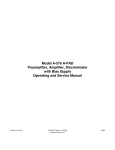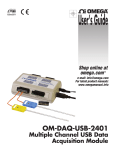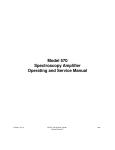Download Model 142PC Preamplifier Operating and Service Manual
Transcript
Model 142PC
Preamplifier
Operating and Service Manual
Printed in U.S.A.
ORTEC® Part No. 717600
Manual Revision B
1202
Advanced Measurement Technology, Inc.
a/k/a/ ORTEC®, a subsidiary of AMETEK®, Inc.
WARRANTY
ORTEC* warrants that the items will be delivered free from defects in material or workmanship. ORTEC makes
no other warranties, express or implied, and specifically NO WARRANTY OF MERCHANTABILITY OR
FITNESS FOR A PARTICULAR PURPOSE.
ORTEC’s exclusive liability is limited to repairing or replacing at ORTEC’s option, items found by ORTEC to
be defective in workmanship or materials within one year from the date of delivery. ORTEC’s liability on any
claim of any kind, including negligence, loss, or damages arising out of, connected with, or from the performance
or breach thereof, or from the manufacture, sale, delivery, resale, repair, or use of any item or services covered
by this agreement or purchase order, shall in no case exceed the price allocable to the item or service furnished
or any part thereof that gives rise to the claim. In the event ORTEC fails to manufacture or deliver items called
for in this agreement or purchase order, ORTEC’s exclusive liability and buyer’s exclusive remedy shall be release
of the buyer from the obligation to pay the purchase price. In no event shall ORTEC be liable for special or
consequential damages.
Quality Control
Before being approved for shipment, each ORTEC instrument must pass a stringent set of quality control tests
designed to expose any flaws in materials or workmanship. Permanent records of these tests are maintained for
use in warranty repair and as a source of statistical information for design improvements.
Repair Service
If it becomes necessary to return this instrument for repair, it is essential that Customer Services be contacted in
advance of its return so that a Return Authorization Number can be assigned to the unit. Also, ORTEC must be
informed, either in writing, by telephone [(865) 482-4411] or by facsimile transmission [(865) 483-2133], of the
nature of the fault of the instrument being returned and of the model, serial, and revision ("Rev" on rear panel)
numbers. Failure to do so may cause unnecessary delays in getting the unit repaired. The ORTEC standard
procedure requires that instruments returned for repair pass the same quality control tests that are used for
new-production instruments. Instruments that are returned should be packed so that they will withstand normal
transit handling and must be shipped PREPAID via Air Parcel Post or United Parcel Service to the designated
ORTEC repair center. The address label and the package should include the Return Authorization Number
assigned. Instruments being returned that are damaged in transit due to inadequate packing will be repaired at the
sender's expense, and it will be the sender's responsibility to make claim with the shipper. Instruments not in
warranty should follow the same procedure and ORTEC will provide a quotation.
Damage in Transit
Shipments should be examined immediately upon receipt for evidence of external or concealed damage. The carrier
making delivery should be notified immediately of any such damage, since the carrier is normally liable for damage
in shipment. Packing materials, waybills, and other such documentation should be preserved in order to establish
claims. After such notification to the carrier, please notify ORTEC of the circumstances so that assistance can be
provided in making damage claims and in providing replacement equipment, if necessary.
Copyright © 2002, Advanced Measurement Technology, Inc. All rights reserved.
*ORTEC® is a registered trademark of Advanced Measurement Technology, Inc. All other trademarks used
herein are the property of their respective owners.
iii
CONTENTS
WARRANTY . . . . . . . . . . . . . . . . . . . . . . . . . . . . . . . . . . . . . . . . . . . . . . . . . . . . . . . . . . . . . . . . . . . . . . . ii
SAFETY INSTRUCTIONS AND SYMBOLS . . . . . . . . . . . . . . . . . . . . . . . . . . . . . . . . . . . . . . . . . . . . . . . vi
SAFETY WARNINGS AND CLEANING INSTRUCTIONS . . . . . . . . . . . . . . . . . . . . . . . . . . . . . . . . . . . . vii
1. DESCRIPTION . . . . . . . . . . . . . . . . . . . . . . . . . . . . . . . . . . . . . . . . . . . . . . . . . . . . . . . . . . . . . . . . . . . 1
2. SPECIFICATIONS . . . . . . . . . . . . . . . . . . . . . . . . . . . . . . . . . . . . . . . . . . . . . . . . . . . . . . . . . . . . . . . .
2.1. PERFORMANCE . . . . . . . . . . . . . . . . . . . . . . . . . . . . . . . . . . . . . . . . . . . . . . . . . . . . . . . . . . .
2.2. INPUTS . . . . . . . . . . . . . . . . . . . . . . . . . . . . . . . . . . . . . . . . . . . . . . . . . . . . . . . . . . . . . . . . . .
2.3. OUTPUTS . . . . . . . . . . . . . . . . . . . . . . . . . . . . . . . . . . . . . . . . . . . . . . . . . . . . . . . . . . . . . . . .
2.4. CONNECTORS . . . . . . . . . . . . . . . . . . . . . . . . . . . . . . . . . . . . . . . . . . . . . . . . . . . . . . . . . . . .
2.5. ELECTRICAL AND MECHANICAL . . . . . . . . . . . . . . . . . . . . . . . . . . . . . . . . . . . . . . . . . . . . . .
2
2
2
2
2
2
3. INSTALLATION . . . . . . . . . . . . . . . . . . . . . . . . . . . . . . . . . . . . . . . . . . . . . . . . . . . . . . . . . . . . . . . . . .
3.1. CONNECTION TO PROPORTIONAL COUNTER . . . . . . . . . . . . . . . . . . . . . . . . . . . . . . . . . .
3.2. CONNECTION TO AMPLIFIERS . . . . . . . . . . . . . . . . . . . . . . . . . . . . . . . . . . . . . . . . . . . . . . .
3.3. INPUT POWER . . . . . . . . . . . . . . . . . . . . . . . . . . . . . . . . . . . . . . . . . . . . . . . . . . . . . . . . . . . .
3.4. TEST PULSE . . . . . . . . . . . . . . . . . . . . . . . . . . . . . . . . . . . . . . . . . . . . . . . . . . . . . . . . . . . . . .
3.5. DETECTOR BIAS INPUT . . . . . . . . . . . . . . . . . . . . . . . . . . . . . . . . . . . . . . . . . . . . . . . . . . . . .
3
3
3
3
3
4
4. OPERATION . . . . . . . . . . . . . . . . . . . . . . . . . . . . . . . . . . . . . . . . . . . . . . . . . . . . . . . . . . . . . . . . . . . .
4.1. GENERAL . . . . . . . . . . . . . . . . . . . . . . . . . . . . . . . . . . . . . . . . . . . . . . . . . . . . . . . . . . . . . . . .
4.2. DETECTOR BIAS . . . . . . . . . . . . . . . . . . . . . . . . . . . . . . . . . . . . . . . . . . . . . . . . . . . . . . . . . . .
4.3. ENERGY OUTPUT . . . . . . . . . . . . . . . . . . . . . . . . . . . . . . . . . . . . . . . . . . . . . . . . . . . . . . . . . .
4.4. TIMING OUTPUT . . . . . . . . . . . . . . . . . . . . . . . . . . . . . . . . . . . . . . . . . . . . . . . . . . . . . . . . . . .
4.5. COMPENSATION ADJUSTMENT . . . . . . . . . . . . . . . . . . . . . . . . . . . . . . . . . . . . . . . . . . . . . .
4.6. INPUT PROTECTION . . . . . . . . . . . . . . . . . . . . . . . . . . . . . . . . . . . . . . . . . . . . . . . . . . . . . . .
4
4
5
5
5
5
6
5. MAINTENANCE INSTRUCTIONS . . . . . . . . . . . . . . . . . . . . . . . . . . . . . . . . . . . . . . . . . . . . . . . . . . . . 6
5.1. TESTING PERFORMANCE . . . . . . . . . . . . . . . . . . . . . . . . . . . . . . . . . . . . . . . . . . . . . . . . . . . 6
5.2. FACTORY REPAIR . . . . . . . . . . . . . . . . . . . . . . . . . . . . . . . . . . . . . . . . . . . . . . . . . . . . . . . . . 8
iv
v
NOTICE
This preamplifier has been shipped to you with its
protection circuit connected into the input circuit.
the protection circuit prevents destruction of the
input FET due to large transients that may occur
during abnormal operating conditions and serves as
an impedance matching termination for the input
cable from the proportional counter. The presence
of the protection circuit imposes only a slight
resolution degradation. With the protection circuit
installed, the preamplifier is immune to almost
anything the operator is likely to do that causes
transients at either the detector input or the bias
input connector.
The protection circuit does not protect the
proportional counter, but even if the proportional
counter breaks down as a result of over-voltage, the
preamplifier will survive the resulting large
transients if the protection circuit is in. This, of
course, would not be true if the protection circuit
were taken out, in which case the input FET is very
susceptible to destruction by transients at the input
connector on the preamplifier.
If the input protection circuit must be taken out for
any reason, this involves disconnecting one
transistor lead and installing a jumper across two
series resistors. The Warranty on the 142PC is void
if the protection circuit is taken out unless all of the
following precautions are taken:
1. COMPLETELY DISCHARGE the bias circuit
before connecting a low impedance, a cable, or any
other capacitive device to the Input connector on
the preamplifier.
2. Discharge the bias circuitry before making any
connections to the Input connector and before
disconnecting the preamplifier from the proportional
counter.
3. To discharge the bias circuitry, connect a low
impedance (shorting cap is preferred) for at least
one minute across the Bias connector on the
preamplifier.
4. Do not short the Input connector to ground, as
the voltage-carrying center pin can become pitted
or burned and form an area where corona discharge
will then develop under normal use.
The Input circuit will be destroyed if the Input
connector is shorted while the bias components are
charged, and the quality of these capacitors is such
that they will retain a charge through a long period
of time. Such a short could result from connecting
a detector, cable, or other capacitive device such
as a voltmeter probe. A short circuit, either short
term or continuous, will cause the applied bias
(stored on C2) to be coupled directly to the input
transistor, causing a catastrophic breakdown.
If a variable bias supply is used, merely turn down
the voltage control to zero and leave it for at least
one minute. This will suffice since the bias circuitry
can discharge itself through the output of the bias
supply.
Sometimes it is necessary to simply disconnect the
bias supply, such as is the case when using
batteries for bias. This situation leaves no discharge
path, so a path must be provided by placing a short
circuit or low impedance across the Bias connector
on the rear panel of the preamplifier. DO NOT
SHORT THE INPUT CONNECTOR on the front
panel of the instrument unless the input circuitry
has been completely discharged.
vi
SAFETY INSTRUCTIONS AND SYMBOLS
This manual contains up to three levels of safety instructions that must be observed in order to avoid
personal injury and/or damage to equipment or other property. These are:
DANGER
Indicates a hazard that could result in death or serious bodily harm if the safety instruction
is not observed.
WARNING
Indicates a hazard that could result in bodily harm if the safety instruction is not observed.
CAUTION
Indicates a hazard that could result in property damage if the safety instruction is not
observed.
Please read all safety instructions carefully and make sure you understand them fully before attempting to
use this product.
In addition, the following symbol may appear on the product:
ATTENTION–Refer to Manual
DANGER–High Voltage
Please read all safety instructions carefully and make sure you understand them fully before attempting to
use this product.
vii
SAFETY WARNINGS AND CLEANING INSTRUCTIONS
DANGER
Opening the cover of this instrument is likely to expose dangerous voltages. Disconnect the
instrument from all voltage sources while it is being opened.
WARNING Using this instrument in a manner not specified by the manufacturer may impair the
protection provided by the instrument.
Cleaning Instructions
To clean the instrument exterior:
! Unplug the instrument from the ac power supply.
! Remove loose dust on the outside of the instrument with a lint-free cloth.
! Remove remaining dirt with a lint-free cloth dampened in a general-purpose detergent and water
solution. Do not use abrasive cleaners.
CAUTION To prevent moisture inside of the instrument during external cleaning, use only enough liquid
to dampen the cloth or applicator.
!
Allow the instrument to dry completely before reconnecting it to the power source.
viii
1
ORTEC MODEL 142PC
PREAMPLIFIER
1. DESCRIPTION
The ORTEC 142PC Preamplifier is a chargesensitive unit that is designed for use with
proportional counters in applications such as soft xrays or low-energy gammas for spectroscopy where
resolution approaching the theoretical limit is
desired. It has been designed to provide the
ultimate in both energy and timing resolution. The
gain provided by the 142PC allows the counter to
be operated at substantially lower voltages, thus
reducing peak position shifts and peak broadening
due to space charge effects in the tube and
simultaneously extending the tube life.
A bias circuit is included to accept the operating
voltage that is required. for the proportional counter.
The bias circuit in the preamplifier includes about
29.5 megohms of resistance, and any detector
leakage current will have to pass through this high
resistance. A voltage drop is expected across this
load resistance, proportional to the detector leakage
current, and this must be added to the bias value to
determine the adjustment level for the bias supply.
An input protection circuit is built into the
preamplifier. It protects the input FET from any
large transient voltages that would otherwise
damage the transistor. This is discussed in the
Notice (inside front cover). The protection circuit
also provides a damping resistance on the input so
that relatively long cable lengths can be used
between the proportional counter and the
preamplifier without disrupting the system stability.
An internal risetime compensation adjustment is
accessible through a hole in the case of the unit.
See Section 4.5 for adjustment information.
A Test Pulse connector with a built-in charge
terminator is provided for use with a pulse
generator such as the ORTEC 419, 448, or 480 to
simulate the signal from the proportional counter.
This allows a check of the system performance
while an experiment is in progress.
The 142PC will accommodate up to ±3000 V bias
for the proportional counter. The output pulse
polarity is the same as the applied bias polarity. The
142PC Preamplifier output can be connected to a
shaping main amplifier such as the ORTEC 451,
485, or 572 for energy spectroscopy, or to a timing
filter amplifier such as the ORTEC 474 for time
spectroscopy.
If it is necessary to open the case for any reason,
observe the following instructions carefully to
prevent serious injury to yourself and/or damage to
the instrument.
Observe the steps that are included in the Notice at
the front of the manual to discharge the high
voltage and prevent shock: the voltage levels that
can be used are lethal and the capacitors are very
high quality so they retain a charge much longer
than normally expected.
Do not touch the high-megohm resistors. R4 and
R7, with your bare fingers; the presence of skin oil
can reduce the resistance of the component and
alter operating characteristics.
See Section 4 for instructions that involve the
protection circuit.
2
2. SPECIFICATIONS
2.1. PERFORMANCE
2.3. OUTPUTS
NOISE
Increases with increasing input
capacitance. Typical performance values, based
on silicon equivalent of , = 3.6 eV at J = 2 :s, are
2.9 keV at 0 pF and 4.1 keV at 100 pF; the typical
slope is 20 eV/pF.
E and T (For Energy and Timing) Two connectors
furnish identical signals through two output paths;
either or both outputs can be used as required, and
they are interchangeable; Ro = 93 S through each
connector and the output polarity is opposite from
the input pulse polarity (output pulse polarity is the
same as bias polarity).
RISETIME Based on a +0.5-V signal through either
output into a 93S circuit and measured from 10%
to 90% of peak amplitude; risetime compensation
adjustment optimized; 25 ns at 0 pF and 150 ns at
100 pF.
SENSITIVITY Nominal, measured through either
output, 300 mV/MeV Si.
ENERGY RANGE 0 to 20 MeV Si.
4
ENERGY RATE 3 X 10 MeV/s.
2.4. CONNECTORS
INPUT AND BIAS Type SHV.
TEST PULSE, E AND T Type BNC.
POWER CABLE 10-ft (3-m) captive power cable,
ORTEC 121-C1; longer lengths available from
ORTEC on special order.
DYNAMIC INPUT CAPACITANCE 1000 pF
#
0.05% for 0 to ±7
INTEGRAL NONLINEARITY
V open circuit or ±3.5 V terminated.
TEMPERATURE INSTABILITY
to 323 K (0 to 50°C)
#±50 ppm/°, 273
DETECTOR BIAS ISOLATION ±3000V
OPEN LOOP GAIN
$40,000
2.2. INPUTS
INPUT Accepts input signals from a proportional
counter and extends operating bias to the
proportional counter.
BIAS Accepts the bias voltage for the proportional
counter from a bias supply.
TEST PULSE Accepts input voltage pulses from
a pulse generator for instrument and system
check and calibration; Rin = 93S.
2.5. ELECTRICAL AND MECHANICAL
POWER REQUIRED Furnished from NIM bin and
power supply through any ORTEC, main amplifier,
or from an ORTEC 114 Preamplifier Power Supply;
built-in captive cable is compatible with either
source.
+24 V, 30 mA; -24 V, 10 mA;
+12 V, 15 mA; -12 V, 15 mA.
DIMENSIONS 1.75 X 5.2 X 4 in., plus 10-ft cable
(44.5 x 132 x 100 mm, plus 3-m cable).
3
3. INSTALLATION
3.1. CONNECTION TO PROPORTIONAL
COUNTER
A direct connection with shielded cable should be
made between the proportional counter and the
Input SHV connector on the preamplifier. The
performance of the 142PC Preamplifier, like that of
all other such low-noise preamplifiers, is degraded
as the capacity at the input increases. Therefore it
is important that the length of coaxial cable used
between the proportional counter and the
preamplifier be kept at the minimum length that is
necessary. Also it is preferable to use 93S or 100S
characteristic impedance cable rather than 75S or
50S cable because the capacity per foot is less for
the cable with the higher characteristic impedance.
Type RG-62/U cable is recommended; this has a
93S impedance and a capacitance of 13.5 pF/ft
(40.1 pF/m). An AMP 51426-2 connector mates
with the SHV connector on the 142PC Preamplifier.
Once the input cable installation has been made,
the electronic noise performance of the 142PC can
be predicted by calculating the cable capacity from
the above information and adding the capacity
expected from the proportional counter.
3.2. CONNECTION TO AMPLIFIERS
Either or both the E and T outputs of the 142PC can
be connected to an amplifier input for further
processing. The output impedance through either of
these connectors is 93S providing series
termination for 93S cable so that long unterminated
cable lengths can be driven easily. Although the
outputs are marked E (for Energy) and T (for
Timing), the pulse characteristics are identical and
the circuits are interchangeable.
In an energy spectrometer system, the preamplifier
output is furnished into a shaping main amplifier. In
a timing spectrometer system, the preamplifier
output is furnished into a timing filter amplifier. With
the dual output connections on the 142PC, the
signals can be furnished simultaneously to both
types of spectrometer systems. If either the E or T
output connector is not being used, it should simply
be left open-circuited (unterminated).
3.3. INPUT POWER
Power for the 142PC is supplied through the Power
Cable that is captive through the rear panel of the
unit. The normal connection for this power cable is
included on the rear panel of the mating ORTEC
amplifier, furnishing ±12 V and ±24 V from the bin
and power supply in which the amplifier is
operating. If this facility is not available or if such a
connection would increase the loading on the bin
and power supply beyond its maximum rated
capacity, use an ORTEC 114 Preamplifier Power
Supply to furnish the operating power requirements
through the captive cable. The ORTEC 114 can
furnish power for two preamplifiers simultaneously
if desired.
3.4. TEST PULSE
A voltage test pulse for energy calibration can be
accepted through the Test Pulse input connector on
the 142PC without the use of an external charge
terminator. The test input of the preamplifier has an
input impedance of 93S and its circuitry provides
charge injection to the preamplifier input. The
shape of this pulse should be a fast risetime (less
than 40 ns) followed by a slow exponential decay
back to the baseline, (200 to 400 :s). While the test
pulses are being furnished, connect either the
detector (with bias applied) or the equivalent
capacitance (without bias applied) to the Input
connector on the 142PC.
The Test Pulse input may be used for the output of
a pulser such as the ORTEC 419 or 448 to calibrate
the preamplifier E output amplitude in terms of
energy for multichannel analyzer calibration.
However, due to stray coupling between the test
circuit and other portions of the preamplifier
circuitry, the transient performance of the
preamplifier is best determined by connecting the
actual proportional counter signal through the Input
connector instead of using the pulse generator
output signals for this calibration.
A voltage test pulse for transient response in the
142PC can be accepted through a charge
terminator and into the Input connector on the
142PC. If external capacitance is to be included for
4
these tests. an SHV tee can be inserted between
the Input connector and the charge terminator, and
this will then accommodate the test capacitances.
Do not furnish any bias during these tests.
3.5. DETECTOR BIAS INPUT
Operating bias for the proportional counter detector
is supplied to the Bias connector on the 142PC and,
through a filter and a large bias resistance, to the
Input signal connector. From there it is furnished
out through the signal input cable to the
proportional counter.
Connect a cable from the detector bias supply
(ORTEC 459 is typical) to the Bias connector on the
142PC. Type SHV connectors are used in this highvoltage circuit and the mating cable should be
furnished with the bias supply module.
4. OPERATION
4.1. GENERAL
When the 142PC is installed according to the
appropriate information in Section 3, it operates at
all times when power is applied from the power
source; this is either from the bin and power supply
through a mating amplifier or from an ORTEC 114
Preamplifier Power Supply. The only adjustment
that will be made in or on the pre- amplifier is an
internal risetime adjustment that is accessible
through the case of the unit.
Figure 4.1 is a simplified block diagram of the
circuits in the 142PC Preamplifier. When the
protection circuit is in, the diode clamp to ground
from a point between two resistors in the input
circuit will protect the input FET transistor from
large transients, which are not a part of the input
pulse information. When the protection circuit is
out, there is no clamp to ground and the two series
input resistors are shorted by a jumper.
Fig. 4.1. Simplified Block Diagram of the 142PC Preamplifier.
5
4.2. DETECTOR BIAS
4.4. TIMING OUTPUT
The amount of bias required to operate the
proportional counter is specified in the data that are
furnished with it. The bias that is accepted into the
preamplifier through the SHV Bias connector is
furnished through the load resistance (about 30
megohms) to the Input SHV connector of the
preamplifier. If the leakage current through the
proportional counter is appreciable, a notable voltage drop will occur across the series load resistance
in the preamplifier, and this must be added to the
detector requirement when the bias supply level is
adjusted.
The T output connector provides an alternate path
for the same output pulses that are furnished
through the E output connector. The intent is to
provide both connections for convenience when the
142PC Preamplifier is used to drive two systems one for energy spectroscopy and the other for
timing spectroscopy.
With the protection circuit in, the input cable can be
removed and reconnected without catastrophic
damage to the preamplifier even when bias is
applied to the circuit; but the user must be very
cautious to prevent touching the interior of the
connector with anything other than a good insulator
because potentially lethal high voltage can be
present on the center pin of the Input connector
under these conditions.
With the protection circuit out, the operating bias
level must be reduced gradually to zero before
the proportional counter is either connected to or
disconnected from the Input connector on the
142PC.
4.3. ENERGY OUTPUT
The charge-sensitive loop is essentially an
operational amplifier with a capacitive feedback
that depends on the stray capacitance of the
feedback resistor; the value of this feedback is
approximately 0.15 pF. The conversion gain is
approximately 300 mV/MeV. If less conversion gain
is desired, a capacitor can be added across the
feedback resistor. Up to 2 pF may be added without
seriously affecting the stability of the preamplifier.
If the feedback is increased to about 1 pF, the
conversion gain is reduced to around 45 mV/MeV.
The energy output signal from the preamplifier is a
fast risetime voltage step with an exponential return
to the baseline in about 75 :s. The polarity of
signals through the E output is inverted from the
signal polarity at the output of the proportional
counter. When the (normal) positive bias polarity is
used for the detector, its output pulses are negative
and the E output of the preamplifier is positive.
4.5. COMPENSATION ADJUSTMENT
A bandwidth compensation control is accessible to
the user of the 142PC. This control can be adjusted
through the bottom of the case without opening the
unit. It is used to tune the preamplifier to the
particular proportional counter that is connected in
order to obtain the fastest risetime for the best time
resolution.
Although a fast risetime is not
necessary for energy measurements, a typical
timing experiment will provide the best timing
resolution when the rise time is optimized with this
control. Because of the high voltages that are
present inside the case when the preamplifier is
operating, a small plastic screwdriver or a TV tuning
tool should be used for this adjustment.
CAUTION
Do not use a metal screwdriver for this adjustment;
there is a possibility of high-bias leakage on the
printed circuit that could cause a severe shock.
When the 142PC Preamplifier is shipped from the
factory, the compensation adjustment has been set
for the specified rise time for a 0-pF input
capacitance; For optimum results for other input
capacities, the control should be adjusted under
actual operating conditions.
If the control has been adjusted for optimum
bandwidth for a specific input capacity and the input
circuit is then changed to provide less capacity,
control readjustment is necessary so that the
preamplifier will not oscillate. If the input capacity is
increased from the value for which the adjustment
has been made, the preamplifier should be stable
and should not oscillate.
6
4.6. INPUT PROTECTION
A provision is built into the preamplifier to protect
the input FET stage from damage when highvoltage transients are applied to its input. These
transients can result from any one or more of many
causes, including detector breakdown, moisture
condensation on the input connector, short circuits
or uncharged capacitance connected across the
input while bias is being applied through the
preamplifier, or disconnection of a bias voltage
without first reducing it gradually to zero.
The protection circuit is installed in the preamplifier
when the unit is shipped from the factory. Although
it offers protection to the FET, it also causes some
degradation of the noise performance of the
preamplifier, which increases as detector capacity
increases.
With the protection circuit in, the collector lead of
Q11 is attached to the center tap of the two series
input resistors to the FET, R39 and R5. Transistor
Q11 is connected as a diode, with both the base
and the emitter tied through R8 to ground. This
prevents the voltage in the input circuit from rising
beyond the safe limit for the FET input. To take the
protection circuit out, simply remove the collector
lead of Q11 from its circuit connection and install a
wire jumper across R39 and R5.
Inherent to all high-speed charge-sensitive
preamplifiers is the problem of keeping the total
system stable while interconnecting the detector
and preamplifier with long cables. To help ease this
problem and permit more flexibility for installations,
the protection circuit is designed to serve not only
as a protection for the FET input but also to
terminate the input cable in a nominal 100S. So it
is recommended that the protection circuit be left in
whenever possible.
In order to take full advantage of the risetime
capabilities of the 142PC for timing experiments
(typical risetimes of 25 to 150 ns for detector
capacities from 1 to 100 pF), the total cable length
should be kept as short as possible, even though it
is terminated. Due to vagaries in the system
installation ! ground loops, stray inductances,
etc.! and since the maximum cable length is a
factor in the input capacitance to the preamplifier,
it is not possible to give absolute numbers.
Generally, two feet is a typical maximum length to
obtain fastest risetimes for low detector capacities.
Of course, the system can be compensated for
cable lengths of up to 5 or 6 feet but slower
risetimes will be obtained. The screwdriver
adjustment inside the case can be used to stabilize
the system and minimize the pulse risetime.
5. MAINTENANCE INSTRUCTIONS
5.1. TESTING PERFORMANCE
As ordinarily used in a counting or spectroscopy
system, the preamplifier is one part of a series
system involving the source of particles to be
analyzed, the detector, the preamplifier, the main
amplifier, and the pulse height analyzer. When
proper results are not being obtained and tests for
proper performance of the preamplifier and the
other components are indicated, it is important to
realize that rapid and logical testing is possible only
when the individual components are separated from
the system. In proving the performance of the
preamplifier, it should be removed from the system
and be dealt with alone, by providing a known
electrical input signal and testing for the proper
output signals with an oscilloscope as specified in
the following steps.
1. Furnish a voltage pulse to the Test Pulse
connector as outlined in Section 3.4. The polarity of
the test pulse signal should agree with the expected
signal input polarity from a proportional counter.
2. Using a calibrated pulser, the 142PC output,
either E or T, should be inverted from the input and
have a nominal scale factor of 300 mV per 1 MeV
equivalent energy (Si).
3. The noise contribution of the preamplifier may be
verified by two basic methods. In either case, the
7
normal capacity of the detector and associated
cables should be replaced by a capacity of equal
value placed across the input connector, and no
bias should be applied. This is necessary because
the noise contribution of the preamplifier is
dependent upon input capacity. The only
meaningful statement of the noise level is one that
relates to the spread caused by the noise in actual
spectra. This can be measured and expressed in
terms of the full width at half maximum (FWHM) of
a monoenergetic signal after passing through the
preamplifier and main amplifier system.
The noise performance referenced in Section 2 is
stated in these terms, and verification methods will
be described. If desired, the preamplifier can be
tested with no external capacity on the
Input connector, in which case the noise width
should be approximately that shown for zero
external capacity. In any case, the input connector
and capacitors, when used, should be completely
shielded electrically. A wrapping of aluminum foil
around the Input connector or a shielding cap
attached to the connector will suffice for testing at
zero capacity.
4. The preamplifier must be tested in conjunction
with an associated main amplifier that provides the
required pulse shaping. The typical noise
performance given in Section 2 is obtained using an
ORTEC 572 Spectroscopy Amplifier on which 2-:s
time constants have been selected as specified. For
comparison of these tabulated values, it is
preferable to test the preamplifier under identical
pulse-shaping conditions. It is also important to
ensure that the noise level of the input stage of the
associated main amplifier does not contribute
materially to the total noise. This is usually no
problem provided that input attenuators, if any, on
the main amplifier are set for minimum attenuation.
5. If a multichannel analyzer is used following the
main amplifier, testing of the noise performance
can be accomplished by merely using a calibrated
test pulse generator with charge terminator. With
only the charge terminator connected to the the
142PC Input, the spread of the pulser peak thus
analyzed will be due only to the noise contribution
of the preamplifier and main amplifier. The analyzer
can be calibrated in terms of keV per channel by
observing two different pulser peaks of known
energy, and the FWHM of a peak can be computed
directly from the analyzer readout.
6. It is also possible to determine the noise
performance of the preamplifier by the use of a
wide-bandwidth rms ac voltmeter such as the
Hewlett-Packard 3400A, reading the main amplifier
output noise level and correlating with the expected
pulse amplitudes per keV of input signal under the
same conditions. Again, a calibrated test pulse
generator is required for an accurate measurement.
In this method the preamplifier and main amplifier
are set up as they would be used normally, but with
a dummy capacitor (or no capacity) on the Input
connector of the 142PC, and with the ac voltmeter
connected to the main amplifier output. The noise
voltage indicated on the meter, designated Erms, is
read and noted. Then a test pulse of known energy,
Ein (in keV), is applied to the Input and the
amplitude of the resulting output pulse, Eout is
measured in volts with an oscilloscope. The noise
spread can then be calculated from the formula
where Erms is output noise in volts on the 3400A
meter, Ein is input signal in keV particle energy, and
Eout is output signal in volts corresponding to the
above input. If the gain of the shaping amplifier is
adjusted so that the output pulse height is 2.35 V for
an input of 1 MeV equivalent charge, then the rms
meter will be calibrated directly in energy (1 mV =
1 keV).
7. The noise performance of the preamplifier, as
measured by these methods, should not differ
significantly from that given in the specifications in
Section 2.
8. lf, during testing of the preamplifier and detector,
the noise performance of the preamplifier has been
verified as outlined in the preceding section or is
otherwise not suspected, a detector may be tested
to some extent by duplicating the noise
performance tests with the detector connected in
place and with normal operating bias applied. The
resulting combined noise measurement, made
either with an analyzer or by the voltmeter method,
indicates the sum in quadrature of the separate
noise sources of the amplifier and the detector. In
other words, the total noise is given by
(Ntot)2 = (Ndet)2 + (Namp)2.
8
9. Each quantity is expressed in keV FWHM. The
quantity Ndet is known as the "noise width" of the
detector, and is included as one of the specified
parameters. By use of the above equation and with
a knowledge of the noise of the preamplifier, the
noise width of the detector can be determined. The
significance of this noise width in evaluating the
detector is subject to interpretation, but generally
the actual resolution of the detector is related
directly to the noise width in its normal applications.
The most useful purpose for determining this
quantity for the detector is occasional monitoring of
the detector noise width to verify that its
characteristics have not undergone any significant
change during use.
10. Use an ORTEC 419 Precision Pulse Generator
with a matched charge termination to measure the
rise time of the 142PC through the T or E output
connector. Connect the 419 output through the
charge terminator to the input of the 142PC and use
an oscilloscope with a fast (1 ns if possible) rise
time. The rise time of the preamplifier can then be
computed by:
(Total risetime)2 = (Preamp risetime)2
+ (Pulser risetime)2 + (Oscilloscope risetime)2.
The risetime of the 419 is typically 3 ns.
5.2. FACTORY REPAIR
This instrument can be returned to ORTEC for
service and repair at a nominal cost. Our standard
procedure for repair ensures the same quality
control and checkout that are used for a new
instrument. Always contact the Customer Service
Department at ORTEC, (865) 482-4411, before
sending in an instrument for repair to obtain
shipping instructions and so that the required
Return Authorization Number can be assigned to
the unit. Write this number on the address label and
on the package to ensure prompt attention when it
reaches the factory.


























